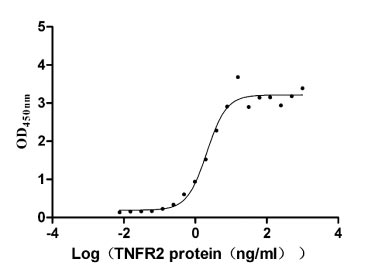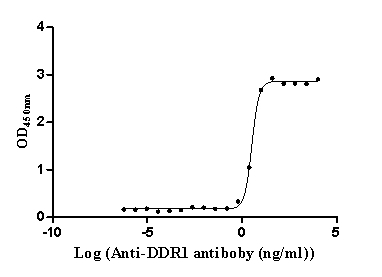Recombinant Human DNA polymerase delta subunit 3 (POLD3)
-
货号:CSB-YP617997HU
-
规格:
-
来源:Yeast
-
其他:
-
货号:CSB-EP617997HU
-
规格:
-
来源:E.coli
-
其他:
-
货号:CSB-EP617997HU-B
-
规格:
-
来源:E.coli
-
共轭:Avi-tag Biotinylated
E. coli biotin ligase (BirA) is highly specific in covalently attaching biotin to the 15 amino acid AviTag peptide. This recombinant protein was biotinylated in vivo by AviTag-BirA technology, which method is BriA catalyzes amide linkage between the biotin and the specific lysine of the AviTag.
-
其他:
-
货号:CSB-BP617997HU
-
规格:
-
来源:Baculovirus
-
其他:
-
货号:CSB-MP617997HU
-
规格:
-
来源:Mammalian cell
-
其他:
产品详情
-
纯度:>85% (SDS-PAGE)
-
基因名:
-
Uniprot No.:
-
别名:DNA polymerase delta subunit 3; DNA polymerase delta subunit p66; DNA polymerase delta; subunit 3; DNA polymerase subunit delta p66; DPOD3_HUMAN; KIAA0039; P66; P68; Pol delta C subunit (p66); Pold3; Polymerase (DNA directed); delta 3; Polymerase (DNA-directed); delta 3; accessory subunit; PPP1R128; Protein phosphatase 1; regulatory subunit 128
-
种属:Homo sapiens (Human)
-
蛋白长度:Full Length of Mature Protein
-
表达区域:2-466
-
氨基酸序列ADQLYLENI DEFVTDQNKI VTYKWLSYTL GVHVNQAKQM LYDYVERKRK ENSGAQLHVT YLVSGSLIQN GHSCHKVAVV REDKLEAVKS KLAVTASIHV YSIQKAMLKD SGPLFNTDYD ILKSNLQNCS KFSAIQCAAA VPRAPAESSS SSKKFEQSHL HMSSETQANN ELTTNGHGPP ASKQVSQQPK GIMGMFASKA AAKTQETNKE TKTEAKEVTN ASAAGNKAPG KGNMMSNFFG KAAMNKFKVN LDSEQAVKEE KIVEQPTVSV TEPKLATPAG LKKSSKKAEP VKVLQKEKKR GKRVALSDDE TKETENMRKK RRRIKLPESD SSEDEVFPDS PGAYEAESPS PPPPPSPPLE PVPKTEPEPP SVKSSSGENK RKRKRVLKSK TYLDGEGCIV TEKVYESESC TDSEEELNMK TSSVHRPPAM TVKKEPREER KGPKKGTAAL GKANRQVSIT GFFQRK
-
蛋白标签:Tag type will be determined during the manufacturing process.
The tag type will be determined during production process. If you have specified tag type, please tell us and we will develop the specified tag preferentially. -
产品提供形式:Lyophilized powder
Note: We will preferentially ship the format that we have in stock, however, if you have any special requirement for the format, please remark your requirement when placing the order, we will prepare according to your demand. -
复溶:We recommend that this vial be briefly centrifuged prior to opening to bring the contents to the bottom. Please reconstitute protein in deionized sterile water to a concentration of 0.1-1.0 mg/mL.We recommend to add 5-50% of glycerol (final concentration) and aliquot for long-term storage at -20℃/-80℃. Our default final concentration of glycerol is 50%. Customers could use it as reference.
-
储存条件:Store at -20°C/-80°C upon receipt, aliquoting is necessary for mutiple use. Avoid repeated freeze-thaw cycles.
-
保质期:The shelf life is related to many factors, storage state, buffer ingredients, storage temperature and the stability of the protein itself.
Generally, the shelf life of liquid form is 6 months at -20°C/-80°C. The shelf life of lyophilized form is 12 months at -20°C/-80°C. -
货期:Delivery time may differ from different purchasing way or location, please kindly consult your local distributors for specific delivery time.Note: All of our proteins are default shipped with normal blue ice packs, if you request to ship with dry ice, please communicate with us in advance and extra fees will be charged.
-
注意事项:Repeated freezing and thawing is not recommended. Store working aliquots at 4°C for up to one week.
-
Datasheet :Please contact us to get it.
相关产品
靶点详情
-
功能:Accessory component of both the DNA polymerase delta complex and the DNA polymerase zeta complex. As a component of the trimeric and tetrameric DNA polymerase delta complexes (Pol-delta3 and Pol-delta4, respectively), plays a role in high fidelity genome replication, including in lagging strand synthesis, and repair. Required for optimal Pol-delta activity. Stabilizes the Pol-delta complex and plays a major role in Pol-delta stimulation by PCNA. Pol-delta3 and Pol-delta4 are characterized by the absence or the presence of POLD4. They exhibit differences in catalytic activity. Most notably, Pol-delta3 shows higher proofreading activity than Pol-delta4. Although both Pol-delta3 and Pol-delta4 process Okazaki fragments in vitro, Pol-delta3 may also be better suited to fulfill this task, exhibiting near-absence of strand displacement activity compared to Pol-delta4 and stalling on encounter with the 5'-blocking oligonucleotides. Pol-delta3 idling process may avoid the formation of a gap, while maintaining a nick that can be readily ligated. Along with DNA polymerase kappa, DNA polymerase delta carries out approximately half of nucleotide excision repair (NER) synthesis following UV irradiation. In this context, POLD3, along with PCNA and RFC1-replication factor C complex, is required to recruit POLD1, the catalytic subunit of the polymerase delta complex, to DNA damage sites. Under conditions of DNA replication stress, required for the repair of broken replication forks through break-induced replication (BIR). Involved in the translesion synthesis (TLS) of templates carrying O6-methylguanine or abasic sites performed by Pol-delta4, independently of DNA polymerase zeta (REV3L) or eta (POLH). Facilitates abasic site bypass by DNA polymerase delta by promoting extension from the nucleotide inserted opposite the lesion. Also involved in TLS, as a component of the tetrametric DNA polymerase zeta complex. Along with POLD2, dramatically increases the efficiency and processivity of DNA synthesis of the DNA polymerase zeta complex compared to the minimal zeta complex, consisting of only REV3L and REV7.
-
基因功能参考文献:
- findings demonstrate a key role of POLD1 and POLD3 in genome stability and S-phase progression revealing RNA-DNA hybrids-dependent effects for POLD3 that might be partly due to its Pol zeta interaction. PMID: 27974823
- The proofreading activity of DNA polymerase delta plays a role in shunting DNA mismatch repair to an EXO1-dependent excision pathway as opposed to directly participating in gap formation via its 3'-5' exonuclease activity. PMID: 28934474
- The mitotic DNA synthesis is RAD52 dependent, and RAD52 is required for the timely recruitment of MUS81 and POLD3 to common fragile sites in early mitosis. PMID: 27984745
- data support Poldelta contributing to translesion synthesis in vivo and suggest that the mutagenesis resulting from loss of Poldelta proofreading activity may in part be explained by enhanced lesion bypass PMID: 27185888
- Studies indicate that DNA polymerase delta 3 (Pol delta3) exhibits significant differences in properties with a major impact on cellular processes in genomic surveillance, DNA replication and DNA repair. PMID: 26916162
- Data suggest that relatively high affinity binding of PolD3-RIR motif to Rev1-C-terminal domain displaces subunits from PolN, Pol-iota, or PolK from Rev1 complex and promotes formation of Rev1/PolZ4 assembly with PCNA for translesion DNA replication. PMID: 26982350
- POLD3 is SUMOylated by SUMO2 in response to replication stress and could play an important role in the regulation of cellular response to DNA replication stress. PMID: 25497329
- Findings provide evidence for the novel concept that Pol delta3 has a role in lagging strand synthesis, and that both forms of Pol delta3 and 4 may participate in DNA replication in higher eukaryotic cells. PMID: 24035200
- In a cyclin E overexpression model of DNA replication stress, POLD3, the human ortholog of POL32, was required for cell cycle progression and processive DNA synthesis. PMID: 24310611
- Pol delta3 is the predominant form of Pol delta at sites of UV damage as a result of p12 degradation; results show that Pol delta at the DNA damage site is the Pol delta trimer lacking p12 regardless of the cell cycle phase PMID: 22801543
- We identified three new CRC risk loci at 6p21 (rs1321311, near CDKN1A; P = 1.14 x 10(-10)), 11q13.4 (rs3824999, intronic to POLD3; P = 3.65 x 10(-10)) and Xp22.2 (rs5934683, near SHROOM2; P = 7.30 x 10(-10)). PMID: 22634755
- Serine-458, located in the proliferating cell nuclear antigen (PCNA)-interacting motif of Poldelta(p68), is a phosphorylation site for protein kinase A (PKA); p68 mutation results in decreased p68 affinity for PCNA as well as processivity of Poldelta. PMID: 22148433
- show that there is a direct interaction between p66 and PCNA in living cells during DNA replication. The dominant negative effect upon growth resulting from expression of p66 sub-domains confirms that the p66-PCNA interaction is essential in vivo. PMID: 16000169
- POLD3, plays a crucial role in the efficient recycling of PCNA during dissociation-association cycles of pol delta during elongation phase of DNA replication. PMID: 17932049
- Taken together, the results provide evidence that concurrent phosphorylation events in p66 may positively and negatively regulate its activity and interactions with other components of the replisome during the cell cycle. PMID: 18157942
- As a first step towards understanding the functional importance of their regulatory subunit interactions, the three-dimensional structure of the p50-p66 heterodimer of human Pol delta has been solved using X-ray crystallography. PMID: 18765914
- the crystal structure of p50*p66(N) complex featuring oligonucleotide binding and phosphodiesterase domains in winged helix-turn-helix N-terminal domain in p66 PMID: 18818516
显示更多
收起更多
-
亚细胞定位:Cytoplasm. Nucleus.
-
数据库链接:
HGNC: 20932
OMIM: 611415
KEGG: hsa:10714
STRING: 9606.ENSP00000263681
UniGene: Hs.82502
Most popular with customers
-
Recombinant Human Lymphotoxin-alpha (LTA) (Active)
Express system: Mammalian cell
Species: Homo sapiens (Human)
-
Recombinant Human Epithelial discoidin domain-containing receptor 1 (DDR1), partial (Active)
Express system: Mammalian cell
Species: Homo sapiens (Human)
-
Recombinant Human Dickkopf-related protein 1 (DKK1) (Active)
Express system: Mammalian cell
Species: Homo sapiens (Human)
-
Recombinant Mouse Cytotoxic and regulatory T-cell molecule (Crtam), partial (Active)
Express system: Mammalian cell
Species: Mus musculus (Mouse)
-
Recombinant Human Myosin regulatory light chain 12A (MYL12A) (Active)
Express system: E.coli
Species: Homo sapiens (Human)




-AC1.jpg)












